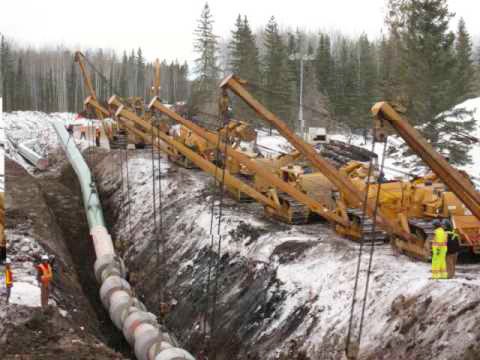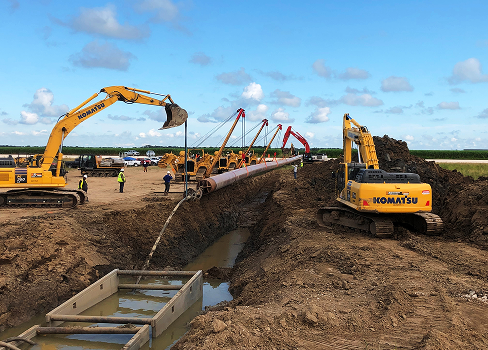Exploring the Most Current Advancements in Pipeline Construction Solutions for Modern Projects
The Pipeline Construction industry is going through significant modifications. Advancements such as smart materials and robotics are reshaping standard practices. These innovations assure to improve performance and safety. In addition, AI technologies are enhancing task monitoring capabilities. As these aspects assemble, they question regarding their lasting influence on sustainability and cost. Comprehending these innovations is vital for stakeholders wanting to navigate this developing landscape. What ramifications do they hold for future projects?
The Surge of Smart Materials in Pipeline Construction
As the demand for much more effective and sustainable Pipeline systems raises, the assimilation of clever products has become a transformative service in Pipeline Construction. These sophisticated products possess unique residential properties that boost the efficiency and long life of pipelines. Self-healing polymers can automatically fix minor leakages, significantly reducing maintenance prices and downtime. In addition, materials embedded with sensing units can check structural integrity and ecological conditions, permitting real-time data collection and evaluation.
Clever materials are corrosion-resistant and usually light-weight, which not just simplifies installment but likewise extends the lifespan of the systems. Their versatility enables pipes to hold up against severe ecological problems, promoting safety and security and dependability. As markets significantly prioritize sustainability, using environmentally friendly wise materials contributes to minimized ecological impact. In general, the increase of wise products marks a noteworthy shift in Pipeline Construction, paving the way for cutting-edge options to satisfy modern infrastructure needs.
Developments in Robotics for Setup and Maintenance
The combination of clever materials in Pipeline Construction is complemented by developments in robotics, which are reinventing installment and upkeep processes. Robotic innovations, such as automated welding systems and drones, boost effectiveness and precision, decreasing human mistake and reducing security dangers. These robotics can operate in tough atmospheres, ensuring that installments are conducted in remote or harmful areas without placing employees in jeopardy.
Additionally, robot examination tools furnished with advanced sensing units offer real-time data on Pipeline honesty, enabling proactive upkeep. They can discover leaks or architectural weak points, enabling prompt treatments that expand the lifespan of Pipeline systems. The use of robotics not only accelerates the Construction timeline but also enhances source appropriation, causing set you back savings. As these technologies remain to advance, they are set to play an important duty in forming the future of Pipeline Construction, guaranteeing dependability and sustainability in facilities advancement.
AI-Driven Job Monitoring Tools Changing Operations
AI-driven project management devices are improving workflows in Pipeline Construction by improving decision-making processes via improved access to real-time data analytics. These tools make it possible for teams to react quickly to task developments, thus enhancing performance. Structured communication channels foster cooperation among stakeholders, even more optimizing job end results.
Boosted Decision-Making Procedures

Real-Time Information Analytics
Utilizing real-time information analytics, contemporary job administration devices change operations in Pipeline Construction. These sophisticated devices utilize fabricated intelligence to give immediate insights right into job efficiency, source allocation, and potential dangers. By constantly keeping an eye on key performance signs, teams can promptly adapt to transforming problems, optimizing labor and materials usage. The assimilation of real-time data permits for more enlightened decision-making, reducing delays and lessening costs. Additionally, predictive analytics can recognize fads and projection obstacles before they escalate, enhancing total job efficiency. As an outcome, Pipeline Construction firms that adopt these AI-driven tools can improve task timelines and outcomes, ensuring they remain competitive in an increasingly complicated sector landscape. This development notes a significant shift towards data-centric management methods.
Streamlined Communication Networks
Efficient interaction is vital in Pipeline Construction, where many stakeholders should work together effortlessly to ensure task success. The introduction of AI-driven task monitoring tools has reinvented communication networks within the market. These tools assist in real-time details sharing, allowing teams to gain access to updates, share papers, and track progress efficiently. By automating routine tasks and giving a central platform for communication, these technologies get rid of misunderstandings and minimize delays. Enhanced exposure right into job timelines and resource appropriation promotes accountability amongst staff member. Furthermore, AI analytics can identify prospective interaction voids, guaranteeing aggressive analytic. Inevitably, structured communication networks not only improve workflow however additionally elevate general task efficiency, making it possible for Pipeline Construction firms to meet contemporary demands effectively.
Boosted Security Protocols With Innovation Combination
The combination of innovation in Pipeline Construction has led to improved safety and security protocols. Real-time monitoring systems, wearable safety tools, and automated danger analyses are now vital parts in reducing hazards on job sites. These technologies not only improve employee security yet likewise enhance compliance with industry regulations.
Real-Time Surveillance Systems
How can real-time surveillance systems transform Pipeline Construction security protocols? By incorporating sophisticated technology, these systems offer continual monitoring of Construction activities, making certain immediate detection of possible hazards. Cameras and sensing units can monitor environmental problems, devices performance, and labor force movements, delivering essential information in genuine time. This aggressive approach allows project managers to determine risks prior to they intensify, considerably enhancing precaution on-site. Furthermore, real-time surveillance promotes compliance with governing requirements, making sure that safety requirements are satisfied consistently. The capability to analyze information instantaneously sustains educated decision-making, making it possible for timely treatments. Consequently, Pipeline Construction tasks can run much more efficiently while guarding the health of workers and minimizing crashes, thereby revolutionizing the industry's security landscape.
Wearable Safety Devices
Frequently, wearable security devices are being integrated into Pipeline Construction to boost security procedures. These innovative devices, consisting of smart helmets, vests, and wristbands, are developed to keep track of worker health and wellness and environmental problems in real-time. Furnished with sensing units, these devices can find hazards such as toxic gas direct exposure, excessive heat, or high noise levels, supplying prompt alerts to workers and supervisors. In addition, wearable technology often includes general practitioner monitoring features, permitting effective location surveillance of personnel on-site. This ability not only aids in quick feedback during emergency situations however additionally improves overall task administration. By prioritizing worker safety and security with modern technology assimilation, Pipeline Construction firms are making substantial strides in minimizing mishaps and advertising a society of safety and security within the market.

Automated Danger Evaluations
While traditional threat assessments typically depend on hands-on assessments, the assimilation of computerized danger assessment technologies is changing safety and security methods in Pipeline Construction. These innovative systems utilize data analytics, man-made knowledge, and artificial intelligence to identify potential risks extra properly and efficiently. By constantly checking environmental problems, tools condition, and employee actions, automated evaluations offer real-time understandings that enhance decision-making. This proactive method decreases the likelihood of crashes and enhances compliance with safety policies. Furthermore, automated danger analyses can be updated quickly, ensuring that all stakeholders have access to the newest information. As a result, Pipeline Construction jobs benefit from a much safer work setting, minimizing interruptions and promoting a culture of safety through modern technology assimilation.
Lasting Practices in Pipeline Construction
As the demand for power framework rises, the Pipeline Construction market increasingly focuses on lasting methods that minimize ecological see here now effect. Firms are adopting environment-friendly products and advanced Construction strategies to lower their carbon impact. As an example, the usage of trenchless modern technology allows for Pipeline installment with minimal interruption to the surrounding atmosphere, protecting natural environments and reducing soil disintegration.
In addition, the application of sustainable energy resources, such as solar or wind, to power Construction tasks is obtaining traction. This change not only decreases dependence on fossil fuels yet likewise enhances the total sustainability of Pipeline jobs. Reliable waste administration practices, including reusing and recycling products, are coming to be criterion in the market.
Real-Time Surveillance and Predictive Upkeep Solutions
The change towards lasting techniques in Pipeline Construction has actually led the method for the assimilation of real-time monitoring and predictive upkeep options. These modern technologies take advantage of progressed sensors and data analytics to continually examine Pipeline integrity and operational effectiveness. By gathering data in genuine time, operators can spot abnormalities such as leaks or pressure declines before they rise right into significant problems. great site This aggressive method not just minimizes environmental risks however also reduces downtime and upkeep costs.
Predictive maintenance utilizes formulas to anticipate possible failures based on historical data and current performance metrics. This enables timely interventions, maximizing maintenance timetables and source appropriation. Overall, real-time monitoring and anticipating upkeep solutions stand for a considerable innovation in Pipeline Construction, boosting security and reliability while supporting sustainability goals. As markets remain to welcome these technologies, the operational landscape of Pipeline administration is established to evolve considerably, ensuring long-lasting viability and efficiency.
The Function of Drones in Checking and Inspection
Drones have actually emerged as transformative devices in the evaluating and evaluation of pipelines, offering boosted efficiency and precision. Their ability to catch high-resolution pictures and videos from numerous angles enables comprehensive analyses of Pipeline stability without running the risk of human safety. Outfitted with sophisticated sensing units and thermal imaging capabilities, drones can discover leaks, rust, and structural anomalies that might not be noticeable to the nude eye.
Furthermore, the release of drones considerably decreases examination time, allowing quicker decision-making for repair and maintenance. This effectiveness translates to cost savings and marginal interruption to surrounding environments. Drones can likewise access hard-to-reach areas, such as sturdy terrains or elevated structures, further increasing the scope of inspections.
As the Pipeline industry remains to accept technological developments, the combination of drones into checking and examination processes is expected to grow, establishing new requirements for operational excellence and safety and security in Pipeline Construction solutions.
Often Asked Questions
What Are the Prices Associated With Modern Pipeline Construction Innovations?
The prices connected with modern-day Pipeline Construction technologies commonly consist of sophisticated products, specialized labor, and cutting-edge technology. These elements contribute to greater initial investment, yet can result in long-lasting savings via boosted efficiency and lowered maintenance requirements.
Exactly How Do Regulative Changes Influence Pipeline Construction Technologies?
Governing adjustments significantly influence Pipeline Construction technologies by demanding the adoption of safer, much more efficient approaches. Compliance requirements often drive technology, leading to advancements in products, layout, and Construction techniques that enhance total project sustainability and security.
What Skills Are Required for Careers in Advanced Pipeline Construction?

Careers in advanced Pipeline Construction need proficiency in engineering concepts, job administration, safety methods, and ecological regulations. Furthermore, abilities in technology integration, synergy, and problem-solving are crucial for passing through the intricacies of contemporary framework jobs.
Just How Can Firms Guarantee Conformity With Environmental Criteria?
To guarantee conformity with ecological criteria, firms should carry out extensive training programs, perform regular audits, and embrace ideal methods in sustainability. Engaging with stakeholders and keeping read this article track of governing adjustments better strengthens their dedication to ecological stewardship.

What Are the Key Challenges Encountering Pipeline Construction Today?
The crucial difficulties dealing with Pipeline Construction today include regulatory compliance, ecological concerns, varying product costs, labor scarcities, and the demand for advanced technology combination (Pipeline Construction Services). These variables complicate task timelines and general efficiency in the market
As the demand for extra effective and sustainable Pipeline systems increases, the integration of smart materials has actually emerged as a transformative solution in Pipeline Construction. AI-driven job administration tools are improving process in Pipeline Construction by enhancing decision-making procedures via better access to real-time data analytics. While job monitoring in Pipeline Construction has actually generally depended on hand-operated processes, the combination of advanced tools considerably boosts decision-making capacities. Taking advantage of real-time information analytics, modern-day job administration tools revolutionize operations in Pipeline Construction. Jobs in innovative Pipeline Construction call for knowledge in design principles, project monitoring, safety protocols, and environmental laws.